Super Mario (series): Difference between revisions
BBQ Turtle (talk | contribs) m (→Friendly species: Updating file name.) |
No edit summary |
||
| Line 155: | Line 155: | ||
===Related games=== | ===Related games=== | ||
These original games are related to the ''Super Mario'' series, while not officially being considered part of it. An important case is that of ''Super Mario World 2: Yoshi's Island'', considered by [[Shigeru Miyamoto]] as part of the core ''Mario'' series in an interview published in 2012.<ref>[http://www.gameinformer.com/b/features/archive/2012/09/24/miyamoto-tezuka-interview.aspx Interview with Shigeru Miyamoto, taken from Game Informer, issue 234]. (Retrieved September 5, 2016)</ref> | These original games are related to the ''Super Mario'' series, while not officially being considered part of it. An important case is that of ''[[Super Mario World 2: Yoshi's Island]]'', considered by [[Shigeru Miyamoto]] as part of the core ''Mario'' series in an interview published in 2012.<ref>[http://www.gameinformer.com/b/features/archive/2012/09/24/miyamoto-tezuka-interview.aspx Interview with Shigeru Miyamoto, taken from Game Informer, issue 234]. (Retrieved September 5, 2016)</ref> | ||
{| align=center width=100% class="wikitable" | {| align=center width=100% class="wikitable" | ||
Revision as of 20:12, February 21, 2018
This article is under construction. Therefore, please excuse its informal appearance while it is being worked on. We hope to have it completed as soon as possible.
- This article is about the main series of Mario platform games. For the series as a whole, not limited to platformers, see Mario (franchise).
Template:Series-infobox The Super Mario series, also called the main series or main games, is the biggest and most important sub-series of the Mario franchise. It started in 1985 with the creation of Super Mario Bros. on the Family Computer and subsequently the Nintendo Entertainment System. It has been followed by many sequels released in almost every Nintendo video game console to date, except the Game Boy, Game Boy Color and the Game Boy Advance, where only remakes, ports, or other spin-offs games were released and development was handled by other divisions and companies.
The series features both 2D platform games, the first of which has been Super Mario Bros., as well as 3D platform games, the first of which has been Super Mario 64. Most of these games, notably excluding Super Mario Bros. 2, follow the story of Mario and, usually, his brother Luigi and sometimes his best friend Yoshi, in their quest to search for and rescue Princess Peach from the clutches of Bowser, who wants to conquer the Mushroom Kingdom or another location, depending on the game. The Mario Brothers' adventure is not easy, however, as they must face Bowser's troops throughout, who attempt to thwart the brothers' attempts to rescue the princess.
The series is developed by several Nintendo divisions. The main games have been developed exclusively by Nintendo Entertainment Analysis and Development. Following its merge with Nintendo Software Planning & Development in September 2015, the series is now handled by Nintendo Entertainment Planning & Development.
In 2010, the series celebrated the twenty-fifth anniversary of the release of Super Mario Bros. The celebration involved a series of videos showing various tricks throughout the series' games on the Wii's Nintendo Channel, as well as releasing a Wii port of Super Mario All-Stars, which included a history booklet of the Super Mario series and a CD containing several songs from games in the series. In 2015, the series celebrated its thirty anniversary with the commemorative game being Super Mario Maker, a game creation platform game that allows players to create their own Mario levels by choosing between four game skins based on other Super Mario games. Special amiibo based on Mario's classic and modern design were released as well.
List of games
Main games
It has been requested that this section be rewritten and expanded to include more information.
| Title | |
|---|---|
| Cover, original release, and system | Synopsis |
| Super Mario Bros. | |
| File:SMB Boxart.PNG Template:Released NES |
On September 13, 1985, Mario starred in his very first game outside of the arcades, Super Mario Bros.. Mario, and his brother Luigi, had to set out on a massive adventure across the Mushroom Kingdom to rescue Princess Toadstool and the Mushroom Retainers from the evil King Bowser. After traversing through eight massive worlds, filled with enemies, the brothers eventually reached Bowser's Castle, finally rescuing Princess Toadstool. Super Mario Bros. was the best-selling video game for the NES in 1999,[1] and, until surpassed by Wii Sports in 2009, the best-selling video game of all time. Super Mario Bros. also had a major part in both the takeoff of the NES and the revival of the American video game industry after the crash in 1983. The game earned Mario a permanent position as Nintendo's mascot, and triggered a massive boom in the video game industry that still continues today. |
| Super Mario Bros.: The Lost Levels | |
| File:SMB TLL Boxart.PNG Template:Released Disk System |
After the extreme success of Super Mario Bros., a sequel was released just one year later in Japan for the Family Computer Disk System. It uses a slightly altered version of Super Mario Bros.'s engine, with different levels and new features including altered graphics and new enemy behavior, such as Bloopers flying in midair, wind to help the player jump across abysses, and other minor changes.
While it was called Super Mario Bros. 2 in Japan, Nintendo of America originally deemed this game too challenging and too much like the original to sell well in western countries[2]. Instead, another game was ported as Super Mario Bros. 2, and the Japanese Super Mario Bros. 2 became known as Super Mario Bros.: The Lost Levels when included in the Super Mario All-Stars port years later. It saw release in its original form in the West only when released on the Virtual Console in 2007. |
| Super Mario Bros. 2 | |
| File:SMB2 Boxart.PNG Template:Released NES |
Owing to the western branches of Nintendo feeling that the Japanese Super Mario Bros. 2 was too similar to the first game and too difficult for U.S. players, they instead chose to port the the Japanese game Yume Kōjō: Doki Doki Panic and release it as Super Mario Bros. 2 in their markets for the NES. New species first appear in this game, including Albatoss and Shy Guys, and it introduces Wart and Birdo. Super Mario Bros. 2 is also the first game to feature four distinctly playable characters, as Mario, Luigi, Princess Toadstool, and Toad had to save the dream world of Subcon from the diabolical Wart. After fighting their way through seven strange worlds, they eventually saved Subcon, and Mario woke up from his dream.
Despite being a port of a pre-existing Japanese game, the western SMB2 would eventually see release in its own right in Japan as Super Mario USA. |
| Super Mario Bros. 3 | |
| File:SMB3 Boxart.PNG Template:Released NES |
Another two years had passed by the time the next mainstream, non-port Mario game had been released: Super Mario Bros. 3. This was by far the most expansive Mario game on the NES, as it featured many levels, items & enemies, and became a huge critical and commercial success. Many of the new species would become staples of the series, including Boos, Fire Piranha Plants and Dry Bones. In the story, Bowser and his seven Koopalings wreaked havoc across the Mushroom World after turning all of the Mushroom Kings into various animals. Mario and Luigi had to traverse through many worlds, castles, seas, forests, and deserts to fix the wrongs the Koopalings had caused. Eventually, the brothers reached Bowser and defeated him, rescuing Princess Toadstool once again. |
| Super Mario World | |
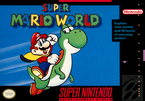 Template:Released SNES |
One year after the release of Super Mario Bros. 3, Super Mario World had been released on a whole new home console — the Super Nintendo Entertainment System. It was with this game that the Mario series had been upgraded from 8-bit to 16-bit graphics. Though the games' graphics would later be revolutionized once again, this was indeed a huge step at the time. During the story of Super Mario World, while Mario, Luigi, and Princess Toadstool were vacationing in Dinosaur Land, Bowser and his seven Koopalings once again kidnapped the Princess. With the help of the Yoshis and Dolphins, the brothers traversed across the vast area of Dinosaur Land. As they made their way to Princess Toadstool, they thwarted each Koopaling who stood in their way until they reached Bowser. Once again, Bowser had been defeated and Princess Toadstool had been rescued. |
| Super Mario 64 | |
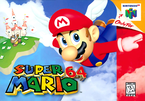 Template:Released Nintendo 64 |
Not long after the release of Super Mario RPG: Legend of the Seven Stars, Nintendo released a new system and a new game — Super Mario 64. The game was a great success. It was the first fully 3-dimensional Mario game to ever be made, thus revolutionizing the appearance of Mario games to date. The game sold over eleven million copies by 2007.[3] Because the game had such amazing success, people began to create rumors of glitches[4] and unlockables in the game. Perhaps one of the most notable rumors was that Luigi was a playable character in the game.[5] This was also the second game to call Princess Peach by her current name (with Yoshi's Safari being the first). In the game, Mario was invited to Princess Peach's Castle to eat a cake she had baked. However, when Mario arrived at her castle, he had discovered that Bowser had taken it over and had stolen almost all of the castle's Power Stars— there were some which he did not know existed. As Mario traversed through fifteen different painting worlds, he eventually recovered enough Power Stars to battle Bowser and take back the castle, freeing Peach from her stained-glass prison. |
| Super Mario Sunshine | |
| File:Box NA - Super Mario Sunshine.png Template:Released GameCube |
In 2002, Mario was back in action in his own three-dimensional platformer once again. While on his way to a vacation with Princess Peach and her loyal steward, Toadsworth, they discover a large glob of Graffiti in the shape of Mario's head at Delfino Airstrip. Mario then finds an interesting machine, called F.L.U.D.D., that helps him rid the island of Graffiti. After he collects a total of ten Shine Sprites, an impostor bearing a striking resemblance to Mario kidnaps Princess Peach. Mario then must redeem his identity (because of Shadow Mario) by ridding the entire island of Graffiti, all the while having to rescue Princess Peach. Towards the end of his adventure, he discovers that Shadow Mario is actually Bowser Jr. in disguise. After fighting Bowser and his son, Mario rescues Princess Peach, finally allowing them to start their vacation. |
| New Super Mario Bros. | |
| File:NewSuperMarioBrothers.jpg Template:Released Nintendo DS |
New Super Mario Bros. is the eighth installment in the Super Mario series. It starts out when Bowser Jr. kidnaps Peach during a strange accident. Luigi is playable in this game as well. Luigi was not playable since Super Mario World. This is the first game since Super Mario World (1990) that features the classic 2D play-style of the Super Mario Bros. games. The game features a solo story mode with Mario or Luigi, a two-player wireless game Mario vs. Luigi, as well as a mini-game mode for up to four players. It was released in 2006 for the Nintendo DS. It spiraled an indirect follow-up, New Super Mario Bros. Wii, and later, a direct sequel, New Super Mario Bros. 2. |
| Super Mario Galaxy | |
| File:SmG.jpg Template:Released Wii |
Super Mario Galaxy is the ninth installment in the Super Mario series and the third 3D game in the series. However, unlike the previous two 3D installments for the Mario series, this game takes place in deep space. Mario attends the Star Festival at the request of Princess Peach, when the town comes under attack by Bowser's air forces. He abducts Peach's entire castle and warps it to the center of the universe, prompting Mario to save her. Most of the game's levels consist of many small planets and planetoids, while others have bigger planets. A new popular species and character appear, Luma and Rosalina. It was released in 2007 for the Wii. This game spiraled a direct sequel, simply called Super Mario Galaxy 2. It is currently the only 3D game that has done so. |
| New Super Mario Bros. Wii | |
| File:Mariobox-noscale.jpg Template:Released Wii |
The indirect follow-up to New Super Mario Bros. for the DS, New Super Mario Bros. Wii was released in November 12, 2009 in Australia. This installment includes four players simultaneously controlling their characters, a feature Shigeru Miyamoto had wanted for years. This game also returns the Koopalings, absent since Mario and Luigi: Superstar Saga, in their first 3-D models. In the story, Bowser and his minions kidnap Peach by using cake as a disguise. Mario, Luigi, Blue Toad, and Yellow Toad travel to eight worlds to save the princess. This game also reintroduces rideable Yoshis, although they can only be ridden in a few levels. The Penguin Suit and the Propeller Mushroom are new power-ups in this game. This game also includes the Super Guide, a demo video for those who are struggling in a particular level. |
| Super Mario Galaxy 2 | |
 Template:Released Wii |
Super Mario Galaxy 2 is the eleventh installment in the Super Mario series. It is also the fourth 3D game in the series and a direct sequel to Super Mario Galaxy. The title contains many elements from its predecessor, such as the story, the adventure being in outer space, recurring objects such as Launch Stars, recurring items including the Bee Mushroom, and the elements of gravity. However, the game introduces new elements such as the utilization of Yoshi and new power-ups such as the Cloud Flower. Rosalina reappears and new characters of the Luma species appear including Lubba. This is the third installment for the Wii in the Super Mario series. |
| Super Mario 3D Land | |
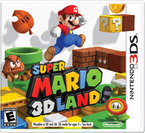 Template:Released Nintendo 3DS |
Super Mario 3D Land is the fifth 3D game in the series, and the twelfth game overall. The levels of Super Mario 3D Land are much more linear and compact than the other 3D titles, more along the lines of the side-scrolling games. Many retro power-ups and characters return, such as Fake Bowsers, the Super Leaf and Boom Boom. New power-ups are also introduced, such as Boomerang Mario, and White Tanooki Mario. It also introduces new enemies and a female partner of Boom Boom named Pom Pom. |
| New Super Mario Bros. 2 | |
| File:NSMB2boxcover.jpg Template:Released Nintendo 3DS |
New Super Mario Bros. 2 is another side-scroller in the series released in 2012 for the Nintendo 3DS. It's the third game in the New Super Mario Bros. line and a direct sequel to New Super Mario Bros. The game features an extremely large amount of coins, which are one of the game's main elements. Raccoon Mario makes a return. A new power-up called the Gold Flower appears and turns Mario into Gold Mario. |
| New Super Mario Bros. U | |
 Template:Released Wii U |
New Super Mario Bros. U is a side-scroller for the Wii U. The game seems to borrow some elements from Super Mario World such as Baby Yoshis, Sumo Bros., Bony Beetles, etc. and minor references like diagonal pipes making a return. The game plays very similar to New Super Mario Bros. Wii with its four-player mode— however, a player with a Wii U GamePad can create platforms in what Nintendo refers to as "Boost Mode". It is the first Super Mario game (and Mario game overall) to be released in high-definition. The game also introduces a new form, Flying Squirrel Mario. |
| Super Mario 3D World | |
 Template:Released Wii U |
Super Mario 3D World is the home console follow-up to Super Mario 3D Land. The game's main feature is the Cat Mario transformation, caused by picking up a Super Bell. It also features the entire playable cast of Super Mario Bros. 2 as playable characters, featuring the same abilities they have in said game. The story follows Mario, Luigi, Princess Peach, and Toad as they attempt to rescue the Sprixie Princesses that Bowser has captured and free the Sprixie Kingdom. |
| Super Mario Odyssey | |
 Template:Released Nintendo Switch |
A platform game titled Super Mario Odyssey released on Nintendo Switch in late 2017. A new entry in the 3D games and a new sandbox-style 3D Super Mario game after Super Mario 64 and Super Mario Sunshine, it focuses on Mario and a new character named Cappy (who takes the form of the Mario Cap) visiting kingdoms far from the Mushroom Kingdom and collecting Power Moons, ultimately in an attempt to prevent Bowser force marrying Princess Peach and to rescue Cappy's sister Tiara. Cappy has multiple uses, such as being thrown like a boomerang (which can be used to control life forms and inanimate objects) and jumping off of him in midair like a platform. In addition, it is the first main Super Mario game to be compatible with amiibo, and was launched alongside a trio of amiibo based on the game. |
Additional games
During the 30th anniversary of Super Mario Bros. the games considered part of the Super Mario series were listed in official material[6]. On pages 238 to 255 of the Encyclopedia Super Mario Bros. all the games released on consoles made by Nintendo and featuring Mario were listed as well, indicating the grade of involvement of Mario in them and indicating as well which games were part of the Super Mario series. In both media two additional games were listed as being part of the Super Mario series, that are also part of the Super Mario Land series. These games are also included as part of the Super Mario game collection in the Mario Portal website, an official portal website dedicated to the Mario franchise, operated by Nintendo Co., Ltd.[7] The official Mario website also lists Super Mario Maker and Super Mario Run alongside these games.[8]
| Title | |
|---|---|
| Cover, original release, and system | Synopsis |
| Super Mario Land | |
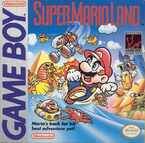 Template:Released Game Boy |
Super Mario Land is the first Super Mario game not developed by Nintendo EAD but rather its partner division: Nintendo R&D1. The game features a similar aesthetic and gameplay to Super Mario Bros. adapting it to the limited technology of the Game Boy at the time. The game is set in the land of Sarasaland and has Mario venture through its four kingdoms to rescue its ruler Princess Daisy from the clutches of the evil alien Tatanga. This game is unique in that it features auto-scrolling shooting sections where Mario ride a submarine or plane. |
| Super Mario Land 2: 6 Golden Coins | |
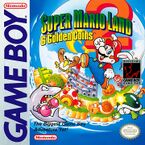 Template:Released Game Boy |
The sequel to the original Super Mario Land, Super Mario Land 2: 6 Golden Coins features aesthetics and gameplay from Super Mario World. After returning from rescuing Daisy in the previous game, Mario discovers his realm of Mario Land has been seized by Wario and has took control of his castle by scattering his 6 Golden Coins. Mario now must venture through the enemy-infested Mario Land to recover his valuable coins and get access to his castle and confront Wario once and for all. |
| Super Mario Maker | |
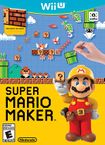 Template:Released Wii U |
Super Mario Maker features a game creation system that allows player to create their own 2D Super Mario levels. Players can choose between four different styles based on Super Mario Bros., Super Mario Bros. 3, Super Mario World and New Super Mario Bros. U for their levels, each adapting certain mechanics and power-ups exclusive to the original games. Level creations can be submitted to the internet so players can share their levels worldwide. Super Mario Maker was released on time for the series's 30th anniversary. |
| Super Mario Run | |
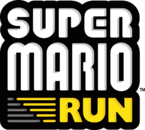 Template:Released iOS Template:Released Android |
Super Mario Run is a side-scrolling, auto-runner platform game and the first dedicated Mario title for mobile devices. It was released first on iOS on December 2016, and was released for Android on March 2017. The game is free-to-start, with optional in-app content to purchase. |
Related games
These original games are related to the Super Mario series, while not officially being considered part of it. An important case is that of Super Mario World 2: Yoshi's Island, considered by Shigeru Miyamoto as part of the core Mario series in an interview published in 2012.[9]
| Title | |
|---|---|
| Cover, original release, and system | Synopsis |
| Super Mario Bros. Special | |
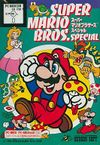 Template:Released X1, PC88 |
Super Mario Bros. Special was made by Hudson Soft for the Sharp X1 and NEC PC88 series of Japanese PCs, and officially licensed by Nintendo. Super Mario Bros. Special was the first licensed sequel to Super Mario Bros. to appear, released a few months before Super Mario Bros.: The Lost Levels in 1986. While superficially very similar to the original Super Mario Bros., the game features original levels but scrolls screen-by-screen rather than smoothly. Jumping and running physics also differ from the original, providing a more challenging experience than Super Mario Bros. Due to the computers' technology being slightly inferior to that of the NES/Famicom, the graphics and audio differ from the original NES game as well, with the X1 utilising more colors and smoother scrolling than the PC88, and does not include Luigi or a multiplayer mode. |
| Super Mario World 2: Yoshi's Island | |
 Template:Released SNES |
While the title suggests it being a sequel, Super Mario World 2: Yoshi's Island is in fact the prequel not only to the Super Mario series but the chronological first game of the whole Mario franchise. The game starts off on the day the Mario Bros. were born and are to be delivered to their parents by a dedicated stork. Foretelling the threat they will represent to the Koopa clan in the future, Kamek tries to kidnap the babies from the stork but only manages to snatch one baby (Baby Luigi) and imprisons stork as well. The other baby (Baby Mario) falls on Yoshi's Island where he is picked by the Yoshis that reside in there. The Yoshis come to the decision to aid the baby to rescue his brother and the stork from the Koopa clan led by the young Baby Bowser. |
| New Super Luigi U | |
| File:Box NA (final) - New Super Luigi U.png Template:Released Wii U |
New Super Luigi U is an additional content pack for New Super Mario Bros. U that was also released as a stand-alone game to celebrate the Year of Luigi, available at retail until the end of the 2013. It has all-new levels and Luigi supplants Mario as the lead character, with Nabbit becoming the fourth playable character, taking Mario's place. |
| Captain Toad: Treasure Tracker | |
Template:Released Wii U |
Captain Toad: Treasure Tracker is a puzzle-platform game, a spin-off and prequel of Super Mario 3D World based on The Adventures of Captain Toad stages from the latter but featuring extensive depth and variety. The game also features Toadette as a new playable character, but also takes the role of damsel-in-distress. |
Ports, remakes, and compilations
| Title | |
|---|---|
| Cover, original release, and system | Synopsis |
| Vs. Super Mario Bros. | |
| File:VS.SMB.png Template:Released Arcade Machine |
VS. Super Mario Bros. is a two-player arcade game released in Japan in 1986. The game is mostly the same as the original Super Mario Bros.; Mario or Luigi went on a quest to save the princess from Bowser and restore order to the Mushroom Kingdom. The game is made harder than Super Mario Bros. in that it had fewer warp zones and more enemies, along with options for the arcade owner to make it more difficult still and thus restrict the time an average player got for their money. The game replaced "duplicate" levels from the original with levels which would later be used in the Japanese Super Mario Bros.: The Lost Levels. |
| All Night Nippon Super Mario Bros. | |
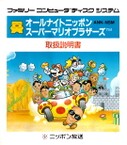 Template:Released Disk System |
All Night Nippon Super Mario Bros. is an officially licensed hack of Super Mario Bros. Gameplay is the same, but many characters such as the Mushroom Retainers are replaced with Japanese celebrities from the radio show All Night Nippon. Other changes are also made for this game, such as World 1 being set during night time and Princess Peach's outfit was changed. The game was only released in Japan. |
| Super Mario Bros. (Game & Watch) | |
 Template:Released Game & Watch |
In 1987, two years after the release of Nintendo's first biggest commercial success, the company released a simplified remake of the game on their Game & Watch system. Being a remake of the game, it essentially has the same plot, reduced down to only eight levels; however, after beating every level, they will have to be repeated. Mario will have to go through nine loops, avoiding Lakitus and Bullet Bills, each time with the levels increasing in difficulty. There are also two types of levels: scroll screen levels, in which Mario will have to reach a certain point to advance, and timer screen levels, in which Mario must get through the world in a given amount of time. Additionally, another difference between the original and this remake is that Mario will find Princess Toadstool at the end of every level, without having to fight a boss. |
| Super Mario All-Stars | |
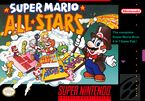 Template:Released SNES |
Super Mario All-Stars, known as Super Mario Collection in Japan, was released in 1993 also for the Super Nintendo Entertainment System. It is a compilation featuring 16-bit versions of the first four main Super Mario series games. Super Mario Bros., Super Mario Bros. 2, Super Mario Bros. 3 and, in its first release outside of Japan, Super Mario Bros.: The Lost Levels. This game updated the four games' graphics and sound to enhance them, with certain changes to the mechanics. A Wii rerelease, called Super Mario All-Stars Limited Edition, occurred in 2010. |
| Super Mario All-Stars + Super Mario World | |
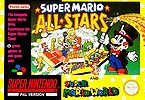 Template:Released SNES |
Super Mario All-Stars + Super Mario World is an America/Europe-only remake of Super Mario All-Stars that also includes Super Mario World for the Super Nintendo Entertainment System. |
| BS Super Mario USA | |
| File:BS SMUSA Mario & Friends.png Template:Released Satellaview |
A pseudo-sequel to Super Mario USA (Super Mario Bros. 2), BS Super Mario USA was released as four installments, and each one involved the player heading into each world to collect a gold Mario statue and defeat the bosses until finally reaching and defeating Wart. Each level could be replayed until the clock reached 50 minutes. As the player progressed, St. Giga's Satellite radio would stream an audio drama to tell the story. After the events of Super Mario Bros. 2, the King of Subcon had golden Mario statues put up all around Subcon, to thank him and his friends for their deeds. However, three Birdos, Mouser, Tryclyde, Fryguy and Clawgrip have stolen them, and now Mario must get them back and defeat Wart again. |
| BS Super Mario Collection | |
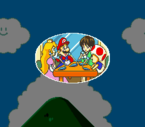 Template:Released Satellaview |
A remake of Super Mario Collection, (Super Mario All-Stars in North America) BS Super Mario Collection is a game for the Super Famicom add-on Satellaview. Like with BS Super Mario USA, as the player progressed through the game, voice acting and music would be streamed to the system using the Satellaview's Soundlink capabilities. |
| Super Mario Bros. Deluxe | |
| File:SMBDX Boxart.PNG Template:Released Game Boy Color |
Super Mario Bros. Deluxe is a Game Boy Color remake which includes the first two Super Mario games ever released: Super Mario Bros. and Super Mario Bros.: The Lost Levels (that last under the name of Super Mario Bros.: For Super Players). Besides those games, it also featured many other collectibles, including images that could be printed with the Game Boy Printer, Cable Link interface multi-player, records sharing by infrared connection, a calendar, a fortune teller, etc. Unlike other remakes, it wasn't developed by Nintendo EAD, but by Nintendo R&D2. |
| Super Mario Advance | |
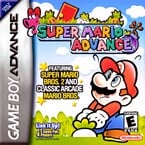 Template:Released Game Boy Advance |
Super Mario Advance is a remake of Super Mario Bros. 2 made for the handheld game system, the Game Boy Advance, and released in 2001. Like the Super Mario All-Stars port, Super Mario Advance had updated graphics. |
| Super Mario World: Super Mario Advance 2 | |
| File:Box NA - Super Mario World Super Mario Advance 2.png Template:Released Game Boy Advance |
Super Mario World: Super Mario Advance 2 is a remake of Super Mario World made for the Game Boy Advance. It is the second title in the Super Mario Advance series and was released in 2002. There are various differences between the original Super Mario World and Super Mario Advance 2. The game was a gigantic hit for Nintendo and the Game Boy Advance, selling 3,290,000 copies in the North America and 5,460,000 copies worldwide. Additionally, Luigi's sprite has been changed and made taller than Mario to match his normal appearance, and the Mario Bros. classic game has been included in the game (like the other Mario Advance games), with multiplayer playable. |
| Yoshi's Island: Super Mario Advance 3 | |
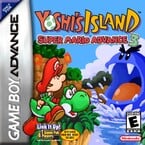 Template:Released Game Boy Advance |
Yoshi's Island: Super Mario Advance 3 is a remake of Super Mario World 2: Yoshi's Island for the Game Boy Advance. The game features similar visuals to the original game, though due to the lack of the Super FX chip, the game tracks behind some graphical aspects. Super Mario Advance 3 has six new levels and Yoshi's Story sound effects. Once again, Mario Bros. is included in the game. |
| Super Mario Advance 4: Super Mario Bros. 3 | |
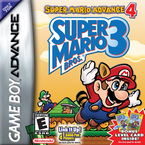 Template:Released Game Boy Advance |
In 2003, the fourth entry in the Super Mario Advance series, Super Mario Advance 4: Super Mario Bros. 3, was released for the Game Boy Advance. It boasted similar graphics and sound to the Super Mario All-Stars version, and made use of the e-Reader. A few e-cards came included with new copies of the game, while two sets (referred to as "series") of cards, were released and sold alongside the game. By scanning special cards into the e-Reader, players were able to upload items, videos, and most importantly, new levels into the game. One notable item was the Cape Feather from Super Mario World, which allowed Mario to transform into Cape Mario. There were also two Switch cards that the player could activate (and deactivate) the effects of by scanning them; the Orange Switch and the Blue Green Switch. Scanning these switches triggered small functions in the game. The e-Reader feature is still available in the European version, but it is disabled by default and unable to access. |
| Classic NES Series: Super Mario Bros. | |
| File:CNS-SMB Cover.jpg Template:Released Game Boy Advance |
The original NES version of Super Mario Bros. was released for the Game Boy Advance as part of the Classic NES series of games in commemoration for the 20th anniversary of the release of the original Famicom and NES. It is a direct port, and as a result features no new additions or bugfixes. Consequently, the only significant difference is that the graphics were downscaled to fit the GBA screen resolution. |
| Famicom Mini: Super Mario Bros. 2 | |
 Template:Released Game Boy Advance |
In Japan, the Classic NES Series were known as Famicom Mini. The original Super Mario Bros. 2 (known in western regions as Super Mario Bros.: The Lost Levels) was released only in Japan. Much like Super Mario Bros., it didn't feature any new additions, the bugs were left untouched, and the graphics were down-scaled. |
| Super Mario 64 DS | |
 Template:Released Nintendo DS |
Super Mario 64 DS is a remake of Super Mario 64. It was released in 2004 for the Nintendo DS. It is also the first Mario game released for the Nintendo DS. Though it is a remake, there are many differences between it and the original (four playable characters and 30 new Power Stars are two examples of this). The game begins the same as the old one; Peach invites Mario to the castle for cake. However, instead of just Mario, Wario and Luigi come for cake, while Yoshi sleeps on the roof of the castle. Bowser then takes over the castle, captures Peach, and locks Mario, Luigi, and Wario inside three rooms. Lakitu then wakes Yoshi up, and now he has to save Mario and the others in order to save the princess once again, this time through teamwork. |
| Super Mario All-Stars Limited Edition | |
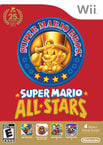 Template:Released Wii |
Released for the Wii in 2010, Super Mario All-Stars Limited Edition celebrates the 25th anniversary of Mario featuring the same games as mentioned in the All-Stars section. It is a port of Super Mario All-Stars. |
| New Super Mario Bros. U + New Super Luigi U | |
| File:Box NA - New Super Mario Bros. U + New Super Luigi U.png Template:Released Wii U |
A compilation of both New Super Mario Bros. U and New Super Luigi U on the same disc, initially released exclusively with the Mario & Luigi Deluxe Wii U set (known as the Premium Pack in Europe). New Super Mario Bros. U + New Super Luigi U includes notable changes to the originals, including a new title screen and over 200 videos included as bonus content. This compilation was released separately as a Nintendo Selects title in 2016. |
| Super Mario Maker for Nintendo 3DS | |
| File:SuperMarioMaker3DSBoxArt.png Template:Released Nintendo 3DS |
A port for the Wii U game released in 2015, Super Mario Maker for Nintendo 3DS was released on December 2, 2016. Despite being a Nintendo 3DS title, the game does not support stereoscopic 3D, and gameplay is therefore strictly available in 2D. Players will be unable to share their levels online and other elements from the Wii U version, like the Mystery Mushrooms and amiibo compatibility, will be absent. |
Major characters
It has been requested that this article be rewritten and expanded to include more information.
Main protagonists
| Character | ||
|---|---|---|
| Image | Brief biography | First appearance |
| Mario | ||
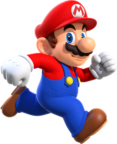 |
Mario is the main protagonist in his titular series of games. Throughout almost thirty years, Mario has been the star of the largest game franchise Nintendo has published. Many characters have fought alongside Mario in his adventures in platformers and RPGs, but many have also fought against him during those times. Mario has gone through many physical changes, from his original 8-bit appearance, to his current 128-bit appearance. Mario commonly rescues Princess Peach, as well as several others, such as Mushroom Retainers, as his adventures continue. Mario has even been accepting enough to team up at times with his greatest foe, Bowser. | |
| Luigi | ||
 |
Luigi is Mario's taller, younger, twin brother. Luigi first debuted alongside Mario in Mario Bros. in 1983, fighting off the many enemies as a plumber. Luigi reappeared in Super Mario Bros. for the NES, playable only in the two-player mode of the game. He later appeared in Super Mario Bros. 2, being playable in one-player mode for the first time along with Toad and Peach. Luigi has appeared in many of Mario's games, but there were some from which he was excluded — among which are Super Mario Land and Super Mario 64. | |
| Princess Peach | ||
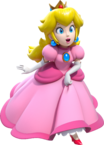 |
Princess Peach — originally "Princess Toadstool" — is the damsel-in-distress of the series. Princess Peach is the ruler of the Mushroom Kingdom, and is protected by many Toads. However, her protection commonly fails and eventually results in her being kidnapped, be it by Bowser, or by another villain. In Super Mario Bros. 2 and Super Mario 3D World, Peach is one of the playable characters and one of the main protagonists. | |
| Toad | ||
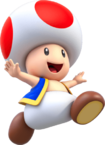 |
Toad originally played the role of Princess Peach's assistant, as well as her guide and guardian throughout her travels; however, he has been reduced to lesser roles since his debut appearance, with his role in main games having sometimes been replaced by Toadsworth. His first playable appearance was in Super Mario Bros. 2. Though he appears identical to many others in his species, Toad is actually an entirely different character; this causes much confusion as to whether or not certain Toads are the Toad discussed. Similar confusion occurs regarding whether he's the same as the character resembling Blue Toad in Super Mario 3D World. | |
| Princess Daisy | ||
 |
Princess Daisy initially served as the damsel-in-distress in her debut game, Super Mario Land. She is the ruler of the country Sarasaland which is inhabited by many various species not found in the Mushroom Kingdom. Although she is the only known ruler, her father was mentioned by her in Mario Party 3. She was kidnapped by the evil alien Tatanga who took her and hypnotized the inhabitants of Sarasaland. After Tatanga's defeat by Mario, Daisy was rescued and the Sarasaland kingdom was restored. Since Daisy's return to the Mario series overall (starting with the Nintendo 64 version of Mario Tennis), she has been a frequent participant in a majority of spin-off installments. 28 years after Super Mario Land, Daisy officially made her reintroduction in the Super Mario series by appearing in Super Mario Run as a playable protagonist. | |
| Yoshi | ||
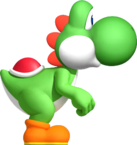 |
Yoshi is Mario's dinosaur companion and one of his most trusty allies during his adventures. In many games Yoshi is present, he is always disposed to give Mario a ride on his back; while riding him and under Mario's command, Yoshi can use his long chameleon-like tongue to swallow a diverse variety of objects, including enemies. Yoshi also supports additional abilities Mario is unable to do on his own like Yoshi's signature Flutter Kick. Super Mario 64 DS features Yoshi as a standalone playable character. In fact, the game opens with Yoshi as the sole playable character that needs to rescue Mario and co. Though he lacks power, he compensates this with his ability to swallow enemies and turn them into an egg, which in turn serves as a homing projectile to take out several enemies at once. | |
| Wario | ||
| File:WarioGoodQual.PNG |
Wario is Mario's yellow-clad, greedy childhood friend and rival. Though he has antagonized Mario since his debut in Super Mario Land 2: 6 Golden Coins, Wario proved to be a valuable ally during the events of Super Mario 64 DS, where he, alongside Luigi, originally came to "crash the party" of Mario and Peach. Wario is the strongest character in the game, being able to destroy some obstacles the other character would have no choice but avoid them. | |
| Rosalina | ||
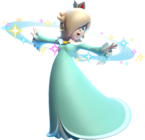 |
Rosalina debuted in Super Mario Galaxy. She reappears as a playable character in Super Mario 3D World, which makes her the second female protagonist along with Princess Peach. She is the adoptive mother of the Lumas, which are also popular to Super Mario Galaxy. Her main duty is to watch the Lumas and help keep the galaxies safe. Throughout Super Mario Galaxy, Rosalina gives helpful and important advice and tips to Mario. | |
| Captain Toad | ||
 |
Captain Toad is a red Toad dressed with an oversized backpack and a headlamp, he is the leader of the Toad Brigade, a group of Toads that provides help to Mario in Super Mario Galaxy and Super Mario Galaxy 2. He subsequently appears in Super Mario 3D World as a playable character in special levels called The Adventures of Captain Toad. | |
| Toadette | ||
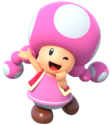 |
Toadette was originally introduced as a playable racing partner for Toad in Mario Kart: Double Dash!! She has since appeared in other games as a playable character and has played supporting roles in several titles. Her first prominent role in the series was in the Super Mario 3D World prequel Captain Toad: Treasure Tracker, where she played a main character the game's storyline. Toadette officially debuted in the Super Mario mainstream series by appearing in Super Mario Run as a referee and later becoming playable in the game. Toadette makes a return to the Super Mario series by playing a role in Super Mario Odyssey as an archivist for the Toad Brigade. | |
| Yellow Toad and Blue Toad | ||
| File:Yellow Toad NSMBW.pngFile:Bluetoad2.png |
Yellow Toad and Blue Toad appear in New Super Mario Bros. Wii as main protagonists along with Mario and Luigi. They reprise the same role in New Super Mario Bros. U. | |
Supporting characters
| Character | ||
|---|---|---|
| Image | Brief biography | First appearance |
| Kings | ||
| File:Smb3mushroomkings.png |
Kings are the rulers of seven kingdoms in Super Mario Bros. 3, were each was turned into a different creature by the Koopalings. | |
| Hoot | ||
 |
Hoot is a friendly owl from Whomp's Fortress in the game Super Mario 64. If Mario wakes him up, he will allow Mario to grab his feet to get a lift. In the remake, he also appears in all missions of Cool, Cool Mountain, and later missions of Snowman's Land, Tiny-Huge Island, and Tall, Tall Mountain. He is similar to the Heavy Zeds. | |
| Dorrie | ||
 |
Dorrie is a large blue Plesiosaur found in Hazy Maze Cave in Super Mario 64. He later appears in World 4 of New Super Mario Bros. In both games, ground pounding of his back will cause him to lower his head for Mario to climb upon; in the latter, he also briefly gains speed. | |
| Toadsworth | ||
| File:Toadsworth artwork -- Super Mario Sunshine.PNG |
Toadsworth is an elderly Toad and Princess Peach's longtime steward where he comes along with Mario and Princess Peach to Isle Delfino. | |
| F.L.U.D.D. | ||
| File:FLUDD.jpg |
F.L.U.D.D., short for Flash Liquidizer Ultra Dousing Device, is Mario's partner in Super Mario Sunshine, and was invented by Professor E. Gadd. It is a sapient water-shooting apparatus that comes equipped with a hovering mechanism; this can be swapped out for turbo and rocket nozzles. F.L.U.D.D. is used primarily to clean up the graffiti left around Isle Delfino by Shadow Mario. | |
| Luma | ||
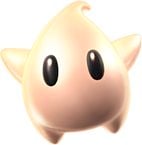 |
Luma is a distinctive character from the species of the same name and Mario's main companion during the event of Super Mario Galaxy and its sequel Super Mario Galaxy 2. It differentiates from its brethren due to its unique beige coloration. | |
| Ray | ||
 |
Ray is a friendly Manta Ray in Super Mario Galaxy that Penguins ride for sport. Mario can also ride him at two points. | |
| Lubba | ||
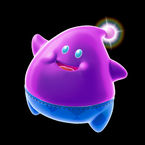 |
Lubba is a pudgy purple Luma and the head honcho of the Lumas in Super Mario Galaxy 2. | |
| Co-Star Luma | ||
| File:AssistLumaSmg2.png |
The Co-Star Luma is an orange Luma that can be controlled by a second player in Super Mario Galaxy 2 when in Co-Star Mode. However, its movement is normally limited to following Mario, although it is capable of immobilizing enemies and picking up items from afar. | |
| Fluzzard | ||
 |
Fluzzard is a large bird from Super Mario Galaxy 2 that is also quite shy. Mario can ride from his talons, similar to Hoot, but he only ever seems to glide. | |
| Cosmic Spirit | ||
| File:Cosmolina.png |
The Cosmic Spirit is an entity resembling both Rosalina and Cosmic Mario, although it is unknown if she has any connection to either of them. She can assist Mario by taking control of his body; however, any stars received will be bronze. She only appears in Super Mario Galaxy 2. | |
| The Chimp | ||
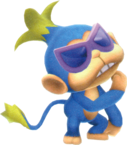 |
The Chimp is a rather competitive monkey from Super Mario Galaxy 2, who appears in many levels having set up challenges for Mario to beat. If Mario succeeds, he awards him a star. | |
| Sprixie Princesses | ||
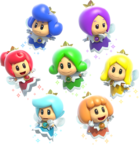 |
Sprixie Princesses are a group of seven characters from Super Mario 3D World. They act as the rulers of the Sprixie Kingdom and the Sprixies, a race of fairies who play a major role in the story. | |
| Plessie | ||
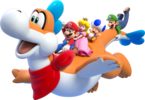 |
Plessie is a rideable dinosaur resembling both Yoshis and Dorrie. He helps the heroes by swimming rapidly through rivers with them on his back. | |
| Cappy | ||
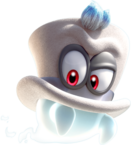 |
Cappy is Mario's main ally throughout the events of Super Mario Odyssey, and assists him in various ways. | |
| Pauline | ||
 |
Pauline was originally introduced as the original damsel-in-distress Mario had to rescue from Donkey Kong's clutches. Presented as Mario's girlfriend, this has long being retconned in her modern appearances that describe her simply as a close friend to Mario instead. Despite being the first female character introduced to the Mario franchise, it took her 36 years to finally appear in a mainstream Super Mario game in Super Mario Odyssey where she is presented as the mayor of New Donk City. | |
| Jaxi | ||
| File:Jaxi SMO.jpg |
Jaxi is a living statue resembling both a lion and a jaguar that Mario can ride in Super Mario Odyssey. It destroys any breakable objects it touches, and defeats small enemies in the same way. | |
| Glydon | ||
| File:SMO Glydon.png |
Glydon is a friendly globetrotting lizard found in Super Mario Odyssey who aspires to glide to and from all the highest places. If Mario captures him, he can use him to glide. | |
Main antagonists
| Character | ||
|---|---|---|
| Image | Brief Biography | First Appearance |
| Bowser | ||
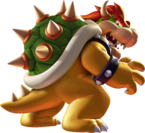 |
Bowser is the main antagonist throughout the Super Mario series, first appearing in Super Mario Bros.. He is the King of all Koopas, and is found to be the final boss in almost all platformers. Commanding the Koopa Troop, Bowser sets to conquer the Mushroom Kingdom by kidnapping its rightful ruler, Princess Peach and holding her captive on his heavily guarded castle. He deploys a countless amount of minions to stop anyone that oppose him. Mario and Luigi have to traverse his castle in order to reach the final confrontation against Bowser. | |
| Wart | ||
| File:Wart Artwork - Super Mario Bros 2.png |
Wart is the main antagonist and final boss of Super Mario Bros. 2. He is leader of the 8 bits, an evil organization that set to conquer the land of dreams known as Subcon; to do so, Wart uses a device called the Dream Machine to create countless amounts of monsters. Wart has one weakness though, he is highly allergic to vegetables. Mario and co. use this to their advantage when they finally confront Wart. With vegetables provided oddly by the Dream Machine, Mario and co. are able to defeat Wart and free the Subcons that were imprisoned by him, bringing peace to Subcon. | |
| Tatanga | ||
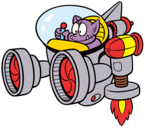 |
Tatanga is the main antagonist in Super Mario Land. Tatanga invaded the kingdom of Sarasaland with the intention of conquering it, he brainwashed its inhabitants to do his bidding and captured Princess Daisy to marry her. Using the Sky Pop, Mario eventually takes down Tatanga on the skies of the Chai Kingdom and finally rescues Princess Daisy. Tatanga comes back in Super Mario Land 2: 6 Golden Coins to serve as the boss of the Space Zone, where he has been entrusted by Wario with one of the 6 Golden Coins, so Mario has to battle him once more to retrieve it. | |
| Wario | ||
| File:SML2 - Wario Artwork.png |
Wario made his debut on Super Mario Land 2: 6 Golden Coins as the main antagonist. It is explained by Mario that Wario has always been jealous of his popularity since they were kids and has tried to steal his castle several times. Wario was able to succeed when Mario was away to free Sarasaland from Tatanga's invasion. To prevent Mario from entering the castle, Wario scattered the 6 Golden Coins all over Mario Land and now are guarded by his underlings. Mario eventually recovers all the Golden Coins, enters his castle and confronts Wario in the throne room. Wario engages Mario in battle using several power-ups but despite his best efforts, he is ultimately defeated and flees. Wario would set to appear in other titles in the series, including many Mario spin-offs and even star his own series. | |
| Bowser Jr. | ||
| File:Bowser Jr. Artwork - Super Mario Sunshine.png |
Bowser Jr. is Bowser's son and first appears as the main antagonist in Super Mario Sunshine where he took the persona of Shadow Mario. He has then appeared throughout the Super Mario series as one of the main bosses. He kidnapped Princess Peach who he thought she was his mother. He is the heir to the Koopa throne. | |
| Dry Bowser | ||
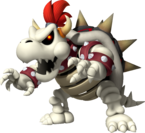 |
Dry Bowser is the undead and skeletal version of Bowser. He made his debut in New Super Mario Bros., where he came about as the result of Mario defeating Bowser by dropping him into lava at the end of New Super Mario Bros.'s first castle. However, both in New Super Mario Bros. 2 and Super Mario 3D Land, Dry Bowser appears even though Bowser isn't turned into a skeleton when he falls into the lava at the end of the final boss battles.[10][11] | |
Supporting antagonists
| Character | ||
|---|---|---|
| Image | Brief Biography | First Appearance |
| Fake Bowser | ||
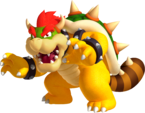 |
Fake Bowsers are members of the Koopa Troop that have been turned into copies of Bowser by his black magic. They are fought at the end of each castle, barring the final, in Super Mario Bros. and Super Mario Bros.: The Lost Levels. In Super Mario 3D Land, they have spiked raccoon tails due to contact with a Super Leaf. However, they are less common in this game. | |
| Blue Bowser | ||
| File:SMBTLL Blue Bowser.png |
Blue Bowser is a dark turquoise member of Bowser's species that is distinct from the Fake Bowsers, as he looks the same when he falls offscreen. His identity is currently stated to be unknown, but in the past he has been considered to be Bowser's brother and later an oddly-colored Fake Bowser. There are fake versions of him as well. | |
| Birdos | ||
| File:Birdo.PNG |
Birdo, along with other members of her species, work for Wart in Super Mario Bros. 2. They have funnel-shaped snouts from which they shoot projectiles. The pink ones shoot eggs, Green and Grey shoot Fireballs, and Red ones can shoot both. They can be defeated by throwing eggs back at them, or with Mushroom Blocks. They appear at the end of most levels. | |
| Mouser | ||
| File:Mouser.jpg |
Mouser is a bomb-tossing rat with sunglasses from Super Mario Bros. 2. He can be beaten by throwing them back at him. A version with pink ears appears in World 1 and a version with green ears appears in World 3. A white one with red ears appears in World 5 in Yume Kōjō: Doki Doki Panic, but it was deemed too difficult when it was being translated and was replaced with Clawgrip. Both Mousers appear identical in Super Mario All-Stars and Super Mario Advance. | |
| Triclyde | ||
| File:Tryclydeadvance.jpg |
Triclyde is a large, 3-headed snake from Super Mario Bros. 2. Two of the heads spit fireballs; the only way to defeat it is with Mushroom Blocks. | |
| Boom Boom | ||
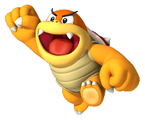 |
Boom Boom is one of Bowser's henchmen. He is an antagonist in the Super Mario series. Boom Boom first debuted in Super Mario Bros. 3, where he battles Mario or Luigi in fortresses, Boom Boom then later made his return appearance in Super Mario 3D Land as one of the game's main antagonists who often appears in airships, along with his partner Pom Pom. | |
| Koopalings | ||
| File:Koopalings - New Super Mario Bros U.png |
The Koopalings are introduced as Bowser’s children in Super Mario Bros. 3 and then considered Bowser's minions from New Super Mario Bros. Wii onwards. They are bosses in various games. Their names are Larry Koopa, Morton Koopa Jr., Wendy O. Koopa, Iggy Koopa, Roy Koopa, Lemmy Koopa and Ludwig von Koopa. | |
| Reznor | ||
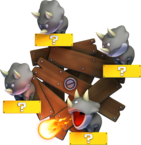 |
Reznor are fire-breathing Triceratops that made their debut in Super Mario World. According to the game's instruction manual, they were cursed by Bowser. They are mid-bosses that Mario and Luigi fight in fortresses found everywhere on Dinosaur Land. They are now found in the Mushroom Kingdom since their appearance in New Super Mario Bros. 2. Similar to how the Koopalings are named after various musicians, Reznor are named after Trent Reznor of the industrial rock band Nine Inch Nails. | |
| Kamek | ||
| File:KamekNSMBW.png |
Kamek is an old, yet powerful Magikoopa and apparent advisor to Bowser (or at least high-ranking member in the Koopa Troop), and the archenemy of Yoshi. He is the main antagonist in the Yoshi franchise while being one of the main bosses in the Super Mario series. | |
| King Bob-omb | ||
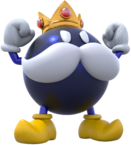 |
King Bob-omb, formerly Big Bob-omb, is a large Bob-omb with a crown, mustache, and no key. He first appeared in Super Mario 64, where he is the first boss. He is fought twice in the remake, and has appeared semi-frequently in spinoffs. | |
| Petey Piranha | ||
| File:Petey Piranha.png |
Petey Piranha is mutant Piranha Plant from Super Mario Sunshine. He appeared twice in that game, once in New Super Mario Bros., and appears semi-regularly in spinoffs. He can fly and spit muddy goop, among other things. His head is similar to that of Dino Piranha, Fiery Dino Piranha, and Peewee Piranha from later games. | |
| Cosmic Mario and Cosmic Clones | ||
| File:Cosmic Mario.png |
Cosmic Mario is a dark blue entity shaped like Mario from Super Mario Galaxy. He looks similar to Shadow Mario, but Mario must race him for the star. He is capable of many of Mario's moves. If the player is using Luigi, Cosmic Luigi will appear instead, and use more shortcuts. In Super Mario Galaxy 2 and Super Mario 3D Land, similar creatures called Cosmic Clones appear. However, they follow Mario or Luigi's exact movements, which can be troublesome if one needs to hold still for a moment or cross a previously-walked path. | |
| Pom Pom | ||
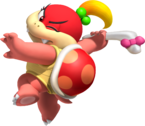 |
Pom Pom often appears on airships where she could fight Mario or Luigi. Pom Pom shares her name with a loose, fluffy material used by cheerleaders and sports fans, or in crafts, the pom-pom. She is related to Boom Boom. | |
| Broodals | ||
 |
The Broodals are a group of rabbit wedding planners in Super Mario Odyssey, whose group name seems to be a portmanteau of "brood," "bridal," and possibly "brutal." Bowser hires them to do the wedding between him and Peach, and when Mario tries to stop the wedding from happening, they attack him. They are led by Madame Broode, an obese red-clad rabbit with a pet Chain Chomp, and are made up of Spewart (in blue), Topper (in green), Rango (in yellow), and Hariet (in purple). | |
Friendly species
| Species | ||
|---|---|---|
| Image | Brief biography | First appearance |
| Toads | ||
 |
Toads are the major residents of the Mushroom Kingdom many many other parts of the Mushroom World, most are loyal subjects of Princess Peach. Unlike the Toads that that serve as playable characters, these non-playable Toads usually bring assistance to Mario and co. in their adventures like hosting the Toad Houses mini-games to earn power-ups or extra lives. In their original appearance in Super Mario Bros., many Toads were transformed into inanimate objects like bricks by Bowser's black magic, while seven important Toads were held kept captive at the end of castle levels. Some Toads seen in Super Mario Bros. 3 seem to serve the kings of each world. In Super Mario 64, Toads were imprisoned within Peach's Castle's walls and paintings, providing some hints to Mario when finally found. A group of six Toads accompanied Mario and Princess Peach on their vacation on Isle Delfino in Super Mario Sunshine. The Toad Brigade was introduced in Super Mario Galaxy, where each member was given a distinctive personality. In Super Mario Run, winning rallies awards the player with numerous Toads to habitate the player's kingdom. | |
| Subcons | ||
 |
Subcons are peaceful fairy-like folk in Super Mario Bros. 2. They reside in and protect the dream world, Subcon. | |
| Yoshis | ||
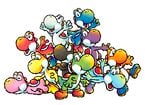 |
Yoshis are a species of friendly dinosaurs native to Yoshi's Island. Originally, only three colored Yoshis were introduced in Super Mario World: green, red, blue and yellow, except for the green one, each colored Yoshi has an unique ability when they swallow a Koopa shell. While it seems Yoshis may be invaluable on their own unless commanded by Mario, they have proved otherwise in many games of the series like in Super Mario World 2: Yoshi's Island, where a group of them agreed on taking Baby Mario on a journey to rescue his captured brother. Regular Yoshis reprise their ridable role in games like New Super Mario Bros. Wii and its sequel, New Super Mario Bros. U. | |
| Piantas | ||
| File:SMS Piantas.jpg |
Piantas are a species of palm-like humanoids originally residents of Isle Delfino. | |
| Nokis | ||
| File:Noki7.png |
Nokis are a race of mollusk-like beings who originate from Isle Delfino as well. | |
| Lumas | ||
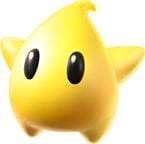 |
Lumas are star-like creatures that first appear in Super Mario Galaxy. | |
| Sprixies | ||
 |
Sprixies are fairy-like creatures appearing in Super Mario 3D World. They are the inhabitants of the Sprixie Kingdom, ruled by the seven Sprixie Princesses. | |
Common and recurring enemies and obstacles
| Species | ||
|---|---|---|
| Image | Brief biography | First appearance |
| Goomba | ||
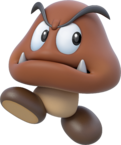 |
Goombas are one of the most common enemies in the Super Mario games, as well as the first and among the most basic. These shiitake-like creatures were once members of the Mushroom Kingdom, but turned traitor when Bowser attacked. They can be defeated with a single jump. They appear in most games; however, Super Mario Bros. 2, Super Mario Land, Super Mario World, and Super Mario Sunshine do not feature Goombas, with their role being given to the Goombo in Super Mario Land and the Strollin' Stu in Super Mario Sunshine. Super Mario World features the related Galoomba, but they are tougher. | |
| Koopa Troopa | ||
 |
Koopa Troopas are common turtle-like foes that retreat into their shells when jumped upon, or in some cases, get knocked out of them. They are among the most basic enemies, and are also one of the most common. They were originally depicted as quadrupedal, but starting with Super Mario World, they begin to walk on two legs, with some exceptions, like in Super Mario Galaxy. Typically, green ones will walk off ledges they come to, while red ones turn away from them. While sometimes simply known as "Koopas," not all Koopas are Koopa Troopas. According to Super Paper Mario, Goombas have had a long-held fear of Koopa Troopas, presumably because of their indestructible and hard-hitting shells. | |
| Koopa Paratroopa | ||
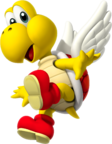 |
Koopa Paratroopas are Koopa Troopas with wings. With some exceptions, the green ones either hop along or move left and right, while the red ones fly up and down. The rare yellow ones in Super Mario World instead chase Mario on foot, and will jump over obstacles. Jumping on them causes them to lose their wings. | |
| Piranha Plant | ||
| File:PiranhaPlantWii.png |
Piranha Plants are carnivorous plants that often live in Pipes, although they are also found planted in the ground, especially in the 3D games. Normally, they cannot be jumped upon, but this isn't the case in the 3D games after Super Mario 64. | |
| Cheep Cheep | ||
 |
Cheep Cheeps are fish that are typically depicted with wing-like fins and mohawks, although there has been some variation. While they normally swim or jump, their exact behavior may vary drastically by game. However, the New Super Mario Bros. series features variations of Cheep Cheeps with different behavior; Deep Cheeps chase Mario and are like normal Cheep Cheeps in every other sense, and the Spiny Cheep Cheep will do the same, but much more aggressively, and will not stay frozen due to the spikes. | |
| Blooper | ||
 |
Bloopers, formerly Bloobers, are white squid-like creatures that usually follow Mario through the water with dangerous speed and accuracy. The ones of Isle Delfino instead travel on land near water, and spit ink, and die if they fall in the water. | |
| Lakitu | ||
| File:Lakitu-NSMBU.png |
Lakitus are cloud-riding Koopas that drop Spiny Eggs, which become Spinies upon hitting the ground. In some games, the cloud can be ridden in after they are defeated. | |
| Spiny Egg | ||
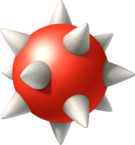 |
Spiny Eggs are dropped by Lakitus and become Spinies when they hit the ground. There is also a green type that doesn't hatch and a kind that turns into Piranha Plants. | |
| Spiny | ||
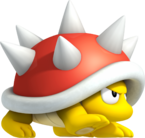 |
Spinies are small, spiked Koopas that cannot be jumped upon. They are dropped by Lakitus as eggs, though some can be found in other places, such as upside down in caves. | |
| Buzzy Beetle | ||
| File:BuzzybeetleNSMBU.png |
Buzzy Beetles are small yet tough Koopas that are immune to fire, and tend to live in caves. They sometimes crawl on ceilings, in which case they will drop when Mario and Luigi come nearby. | |
| Hammer Bro | ||
| File:Hammer Bro-NSMBU.png |
Hammer Bros are Koopas that are commonly found in pairs, and throw an endless supply of Hammers. Relatives include Boomerang Bros, Fire Bros, Sledge Bros, Sumo Bros, and Ice Bros. One Hammer Bro from the first game is, retroactively, a unique character in the Mario franchise; he is referenced in Paper Mario: The Thousand Year Door, and is Hamma Jamma's grandfather. According to Hamma Jamma, World 7-1 was his "hood." | |
| Bullet Bill | ||
 |
Bullet Bills are ammunition that usually travel in a straight line. In some of the 3D games, they will follow Mario, a behavior that is similar to the Bull's-Eye Bills in the 2D games. | |
| Bill Blaster | ||
| File:Bill Blasternsmbwii.PNG |
Bill Blasters are two-sided cannons that shoot Bullet Bills. They are usually emblazoned with a skull. In Super Mario 64 and Super Mario 64 DS, they are grey cubes with a scrap metal-like texture and only one cannon. Super Mario 64 is notable for having only one of these enemies in the entire game; it is located at the beginning of the staircase to the top of Whomp's Fortress. Super Mario 64 DS, however, adds another in a new area behind Whomp's Fortress, as well as some in Dire, Dire Docks. | |
| Lava Bubble | ||
 |
Lava Bubbles, formerly Podoboos, are balls of fire that leap out of Lava. Starting in Super Mario World, their design sometimes includes eyes. | |
| Fire Bar | ||
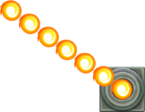 |
Fire Bars, are rows of fireballs rotating around blocks. Their length varies greatly, and are commonly found in castle levels. | |
| Wind | ||
| File:WorldA-3SMBTheLostLevels.png |
Wind pushes Mario around, potentially into an abyss. However, it can also push him out of an abyss, or across a gap. It appears in many levels of Super Mario 64, and it makes a notable appearance in World 2-4 of New Super Mario Bros Wii. Fwooshes, Wind Spirits, and Ty-foos, along with Gusties from the Yoshi franchise are all enemies relating to wind. | |
| Shy Guy | ||
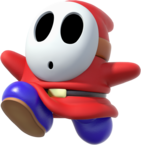 |
Shy Guys were Wart's main troops in Super Mario Bros. 2. They are notable for their amount of subspecies, but have for the most part been relegated to spinoffs. In Super Mario Bros. 2, the red ones walked off of ledges and the pink ones turned around. The pink ones were blue in the remakes. | |
| Bob-omb | ||
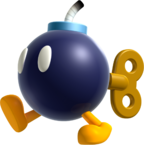 |
Bob-ombs are walking bombs. In some games, they actively chase Mario before exploding; in others, they won't ignite until Mario attacks them. In the Paper Mario series, they are noted for their short tempers. | |
| Pokey | ||
| File:PokeyNSMBU.png |
Pokeys are tall segmented cacti. While it has been inconsistent as to whether or not it's safe to jump upon them, the head is usually the weak point. | |
| Spike Trap | ||
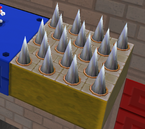 |
Spike Traps are areas of sharp, pointy spikes that can power down the Mario Bros and can take away health and lives. Spike Traps are either stationary, retractable, attached to a moving object, or any combination of these positions. Yoshi, however, is normally immune to their harmful effects. | |
| Fire Piranha Plant | ||
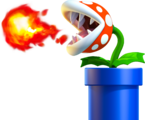 |
Fire Piranha Plants, also known as Venus Fire Traps, are fire-spitting Piranha Plants. A similar species called the "Magic Piranha Plant" appeared in The Super Mario Bros. Super Show!. | |
| Paragoomba | ||
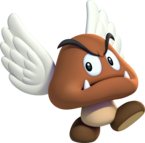 |
Paragoombas are winged Goombas. Some of them jump, some fly back and forth, and others drop parasitic Micro-Goombas. Jumping on them causes them to become Goombas. | |
| Micro Goomba | ||
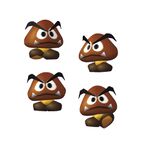 |
Micro Goombas, also known as Mini Goombas and Small Goombas, are miniature Goombas. They are often parasitic, weighing Mario down; these are sometimes called Mugger Micro-Goombas. There are also a kind that hides under Brick Blocks and jumps with them; these are Pile Driver Micro-Goombas. The ones in Super Mario Galaxy, however, were barely smaller than ordinary Goombas, and had rounder heads, looking vaguely like Goombos. They were also olive green. | |
| Boomerang Bro | ||
| File:Boomerang Bro SM3DL.png |
Boomerang Bros are Hammer Bros that wield Boomerangs. They are commonly found alone, and usually have blue shells, although the ones in Super Mario Bros. 3 had black shells and either green or light blue skin, with the remakes giving them all green skin. | |
| Dry Bones | ||
| File:Dry Bones.png |
Dry Bones are skeletal Koopa Troopas that often appear in castles. When jumped upon, they will temporarily fall apart, putting themselves back together after a few moments. | |
| Cannon | ||
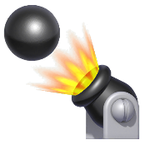 |
Cannons are commonly found on Airships and shoot Cannonballs. There also exists a living, pig-like cannon called Bomubomu as well as a bipedal one called Kaboomba. | |
| Boo | ||
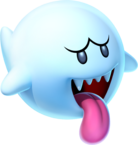 |
Boos, formerly known as "Boo" Diddlies and Boo Buddies, are shy, spherical ghosts that attack only when Mario's back is turned from them. Other behaviors are exhibited by Circling Boo Buddies, Boo Buddy Snakes, Boo Blocks, Disappearing Boo Buddies, Boo Buddy Swarms, and Bomb Boos, as well as the Boos of Super Mario Sunshine. They are known for their large tongues and short arms, and most famously, their shy personality, hence attacking only when the plumbers' backs, or anyone's, for the matter, are turned. | |
| Thwomp | ||
| File:ThwompNSMBU.png |
Thwomps are floating stone faces that crash down either when Mario gets close, or in a set pattern. | |
| Chain Chomp | ||
 |
Chain Chomps are large iron balls that act similar to guard dogs, with chains holding them back. Without the chain, they are simply called Chomps. | |
| Fire Bro | ||
| File:Fire Bro-NSMBU.png |
Fire Bros are Hammer Bros that produce fire. Originally, they were depicted as shooting the fire from their mouths, but later, they threw it like their relatives. | |
| Burner | ||
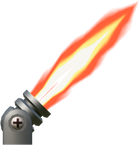 |
Burners, also known as Rocket Engines, are fire-shooting cannons commonly found on Airships. Similar enemies include Fire jets and Fire Cannons. | |
| Rocky Wrench | ||
| File:RockyWrenchNSMBW.png |
Rocky Wrenches are depicted either as mole-like Koopas or a possible relative of Monty Mole. Regardless, they hide under manhole cover-like lids and throw wrenches. They are similar to the Montys of Super Mario Galaxy, and may be intended to be the same thing. | |
| Spike | ||
 |
Spikes are Koopas that throw an endless supply of spiked balls from their mouths, or spiked bars in Super Mario 3D World. | |
| Spiked Ball | ||
| File:SpikedBall-NSMBW.png |
Spiked Balls are huge metal spheres covered in spikes, and were initially depicted as being thrown by Spikes. Since then, they have appeared independently. | |
| Muncher | ||
| File:MuncherNSMBU.png |
Munchers are small, but invulnerable Piranha Plants that are usually black. Goomba's Shoe and Yoshi can be used to walk on them. | |
| Big Goomba | ||
| File:Bignsmall.PNG |
Big Goombas, also called Grand Goombas and Giant Goombas, are large Goombas with similar behavior to their smaller counterparts. In Super Mario 64, punches and kicks would not affect them, but they could be Ground Pounded for a Blue Coin. However, jumping on the ones in Super Mario Galaxy and Super Mario Galaxy 2 would hurt Mario to jump on, regardless of his position. In New Super Mario Bros. Wii, jumping on them splits them into two ordinary-sized Goombas. They are not to be confused with Mega Goombas, which are a size larger, and split into two Big Goombas when jumped on, of four Goombas when Ground Pounded. | |
| Big Piranha Plant | ||
 |
Big Piranha Plants, sometimes called Piranhacus Gigantici, Giant Piranha Plants, and Super Piranha Plants, are large Piranha Plants, that are more often found outside of Pipes than in. | |
| Sledge Bro | ||
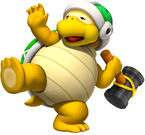 |
Sledge Bros, sometimes misidentified as Sumo Bros, and large Hammer Bros that cause stunning shockwaves when they jump. | |
| Bull's-Eye Bill | ||
 |
Bull's-Eye Bills, also known as Missile Bills, are targeting Bullet Bills that are usually red or orange, but purple ones exist as well. The scope of their targeting has changed immensely; the ones in Super Mario Bros. 3 and Super Mario Sunshine could only turn laterally, while the ones in New Super Mario Bros. Wii and beyond can turn in any direction. The Bullet Bills of Super Mario 64, Super Mario Galaxy, as well as some in Super Mario Galaxy 2 exhibit similar targeting behavior. | |
| Flame Chomp | ||
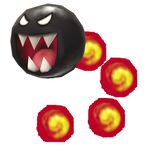 |
Flame Chomps, formerly Fire Chomps, are Chomps that fly and can spit fire. Once their fire is used up, they eventually explode. Smaller, invincible versions known as Keronpa Balls appear in Super Mario 64. | |
| Spiny Cheep Cheep | ||
| File:SpinyCheepNSMBU.png |
Spiny Cheep Cheeps are spiked versions of Cheep Cheeps that, depending on the game, either swim quickly across the screen or quickly chase Mario. | |
| Falling Spike | ||
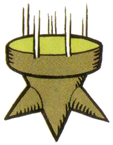 |
Falling Spikes are spikes on the ceiling, sometimes stalactites, that fall down. They are similar to the Icicles that first appeared in Mario Bros. | |
| Galoomba | ||
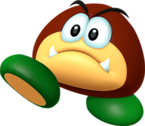 |
Galoombas, formerly "Goombas," are a relative of Goombas that aren't squished by jumping, instead stunning them. In Super Mario 3D World, they could be crushed with a Ground Pound, but not picked up and carried, like in Super Mario World. | |
| Monty Mole | ||
 |
Monty Moles are creatures that resemble moles or gophers that pop out of the ground. Some throw rocks at Mario and then quickly hide back underground. | |
| Chargin' Chuck | ||
 |
Chargin' Chucks are American Football-playing Koopas that take multiple hits to defeat. In Super Mario World, they also had a very wide variety of attacks. | |
| Swoop | ||
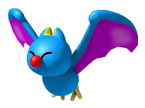 |
Swoops, also known as Swoopers, are bats that often hang from the ceilings of caves, when they see Mario, they swoop down upon him. | |
| Spike Top | ||
| File:SpiketopNSMBW.png |
Spike Tops are spiked Buzzy Beetles with the ability to walk on almost any surface, including walls, in addition to being immune to fire and stomping. They were initially depicted with six legs, although that has long since been abandoned. They are currently depicted with angry faces in comparison to Buzzy Beetles. | |
| Spinner | ||
 |
Spinners, also known as Ball 'n' Chains, are spiked balls on the ends of chains that swing around in a large circle, similar to Roto-discs. | |
| Urchin | ||
| File:UrchinNSMBU.png |
Urchins are spiny blue or purple echinoderms that move around by either rolling or floating. | |
| Magikoopa | ||
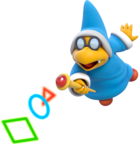 |
Magikoopas are Koopa wizards that can summon other enemies or Fireballs with their magic. A notable member is Kamek. | |
| Fuzzy | ||
| File:Fuzzy-NSMBU.png |
Fuzzies are black spiny creatures that usually follow rails in the air. They are not to be confused with the psychedelia-causing creature of the same name. | |
| Porcupuffer | ||
| File:PorcuPufferNSMBU.png |
Porcupuffers are massive spiky indigo Cheep Cheeps that swim quickly along the surface of the water, and since New Super Mario Bros. Wii, leap from it. They can also break free from ice almost immediately. | |
| Fish Bone | ||
 |
Fish Bones are skeletal Cheep Cheeps. Originally, they swam forward, occasionally darting. In Super Mario Galaxy, they were given a more torpedo-like appearance and behavior. New Super Mario Bros. Wii switched to a design similar to the original, but kept the torpedo-like behavior. Honebon is also stated to be a skeletal Cheep Cheep, but it slowly swims in an upside-down "V" pattern. | |
| Torpedo Ted | ||
| File:Torpedo Ted SMW.png |
Torpedo Teds are underwater counterparts to Bullet Bills. They typically come from Skull Boxes. | |
| Wiggler | ||
| File:Wiggler Artwork - Super Mario Galaxy 2.png |
Wigglers are cheerful yet easily-irritable caterpillars with flowers on their heads. When they metamorphose, they become Flutters. | |
| Banzai Bill | ||
 |
Banzai Bills are massive Bullet Bills that can be difficult to avoid, due to their size. | |
| Big Boo | ||
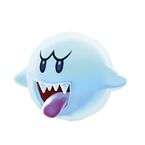 |
Big Boos are large Boos that have appeared as both enemies and bosses. | |
| Skewer | ||
 |
Skewers, also known as Spike Pillars, are large spiked beams that shoot out to attack. | |
| Grinder | ||
 |
Grinders are large saw blades that follow tracks, although even larger versions exist as well. In Super Mario Galaxy 2, they instead cut up Puzzle Plank Galaxy, and in Super Mario Maker, placing them off of a track causes them to simply spin in one place. | |
| Boulder | ||
 |
Boulders make their first appearance being dug up by Diggin' Chuck. They later appear in various other games, and Mario can even become one with the Rock Mushroom. | |
| Mechakoopa | ||
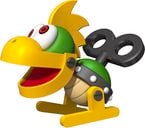 |
Mechakoopas are wind-up toys resembling Bowser. Jumping on them usually causes them to go into a dormant state, where they can be picked up and thrown. In Super Mario Galaxy, they are bulkier, only go dormant when hit with a Star Spin, can't be picked up, and breathe fire. | |
| Whomp | ||
 |
Whomps are bipedal relatives of Thwomps that attack by falling face-forward, thus exposing their weak point, their backs. | |
| Maw-Ray | ||
| Maw-Rays (formerly known as Unagi) are large moray eels that often hide away in caves. Similar creatures are Gringills and Spike Eels, as well as Eely-Mouth. | ||
| Amp | ||
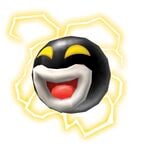 |
Amps are electric spheres that are often found circling things. This is similar to the enemies Spark, Hothead, Li'l Sparky, and Piro Dangle, but they are all considered different things. | |
| Scuttlebug | ||
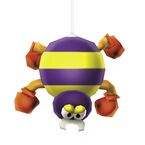 |
Scuttlebugs are spiders that often jump or hang by webs. | |
| Bully | ||
 |
Bullies are spherical enemies that attack by pushing Mario around. Mario must do the same to beat them. | |
| Skeeter | ||
 |
Skeeters are water-strider creatures. Their appearance and aggressiveness, along with the effect of jumping on them, has varied. There is also a bomb-dropping version. | |
| Tox Box | ||
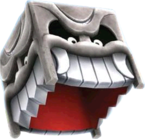 |
Tox Boxes are cube enemies with one hollow side Mario can stand under without getting crushed. The ones in Super Mario 64 and the ones in Super Mario Galaxy have vastly different appearances, as well as slightly different Japanese names. | |
| Pokey Head | ||
| File:PokeySproutSMS.png |
Pokey Heads are single-segmented Pokeys. While they have technically appeared since Super Mario Bros. 2 due to Pokeys being reduced to a head when their segments are destroyed, the Pokey Heads from Super Mario Sunshine are distinguished by their different behavior, in which they disguise themselves as flowers and pop out of the ground when approached, slowly hopping after Mario. The ones in Super Mario Galaxy were green. Due to this version appearing in Super Mario Galaxy 2, they are also notably the last Pokeys to have the floral design. | |
| Cataquack | ||
| File:Cataquack.jpg |
Cataquacks are blue creatures resembling both ducks and Wiggler segments, and are native to Gelato Beach. When they see Mario, they will chase him and fling him up in the air, but are unlikely to damage him. In Super Mario Galaxy, they are outright unable to damage Mario, but Mario is unable to defeat them. Also in Super Mario Galaxy, they respawn if they fall in water. Super Mario Sunshine also has an aggressive red type that will damage Mario far easier. Additionally, green and purple ones appear in the Mario Kart series alongside blue and red ones, but they all act the same there. | |
| Deep Cheep | ||
| File:DeepCheepNSLU.png |
Deep Cheeps are aggressive green Cheep Cheeps that chase Mario. They were originally depicted with white mohawks, but they have since been switched to yellow. | |
| Cheep Chomp | ||
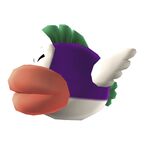 |
Cheep Chomps are purplish relatives of the carnivorous Boss Bass, that swim through the water looking for food. Getting eaten by one will cost a life, regardless of Mario's current form. | |
| Volcanic Debris | ||
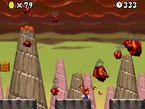 |
Volcanic Debris refers to rocks that fall from the shy after being launched from volcanoes. It is highly destructive, being able to break through any kind of block, and well as set off Kab-ombs. | |
| Octoomba and Octo-Army | ||
| Octoombas, formerly known as Electrogoombas, are aliens that attack by headbutting or shooting projectiles. Relatives include Octoguys, Octopuses, Elite Octoombas, and Octoboos. They are led by King Kaliente and Prince Pikante. | ||
| Sentry Beam | ||
  |
Sentry Beams are primarily laser-using robots, with various types, such as a purple one that can be bounced upon and shoots rings of electricity, a green one that can also be bounced upon but releases Topminis, a yellow one that makes electric rings but has a top resembling a screw, or sometimes is covered in spikes, and a grey kind that shoots lasers straight at Mario and isn't bouncy. Ring Burners are similar. | |
| Eep Cheep | ||
| File:YellowCheepCheepNSMBU.png |
Eep Cheeps are skittish yellow Cheep Cheeps found in large schools. They are similar to an unused enemy from Super Mario Bros. 3. | |
| Magmaargh | ||
 |
Magmaarghs are a subspecies of the Blarrg enemy from Super Mario World, and far more common. They lunge up from underneath lava in an attempt to eat Mario. They have some subspecies of their own, Magmaws, Sandmaarghs, and Charvaarghs. | |
| Biddybud | ||
 |
Biddybuds are variously-colored ladybug-like creatures found marching around in groups. There is also a winged variety; both can be defeated instantly with any attack. | |
| Peepa | ||
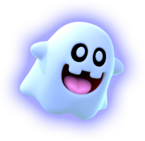 |
Peepas are Boos with faces that resemble the Boos of the Super Mario World cartoon. They are not shy, and will happily look eye-to-eye with Mario as they follow their preset paths. In New Super Mario Bros. 2, some Peepas act like Circling Boo Buddies, while others carry platforms. | |
See also
References
- ^ Best-selling NES game
- ^ Extreme difficulty of Super Mario Bros.: The Lost Levels
- ^ Super Mario 64 sales results
- ^ Rumored glitches in Super Mario 64
- ^ Rumors of Luigi in Super Mario 64
- ^ Template:Media link
- ^ Super Mario game collection, Mario Portal website (Japanese)
- ^ Listed here among other Super Mario series games.
- ^ Interview with Shigeru Miyamoto, taken from Game Informer, issue 234. (Retrieved September 5, 2016)
- ^ GameXplain (August 17, 2012). New Super Mario Bros 2: Ending & Credits (Spoilers!). Youtube. Retrieved April 22, 2016).
- ^ ❤Sunny❤ (February 17, 2016). Super Mario 3D Land - Final Boss Battle & Ending. Youtube. Retrieved April22, 2016.